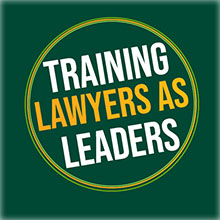
Guest Post by Baylor Law Student Rikki Feezor
Below is a short book review written by Rikki Feezor, a law student in our latest leadership development class. With this month’s focus on feedback as a critical component of learning and growing in leadership, we invite you to read Rikki’s review of The Talent Code: Greatness Isn’t Born. It’s Grown. Here’s How. by journalist and New York Times bestselling author Daniel Coyle. Coyle’s advice for maximizing one’s potential highlights the importance of Master Coaches who give constructive feedback and recipients being open to learning from feedback and failure with a mindset for growth.
The Talent Code tackles the age-old question of nature versus nurture. Are people born with better skills than others, or does everything come down to practice, practice, practice? This book takes a very scientific approach to determining how we as humans process information to learn skills. The overall theme is that learning is the most crucial part of life or, at the very minimum, one of the most crucial parts of life. We are taught all these subjects growing up, yet why are we never taught how to learn? By visiting “talent hotbeds,” small places around the world that produce statistically impossible numbers of great athletes, artists, and performers, author Dan Coyle discovers what lies behind excellence. The Talent Code mentions three foundational elements of mastering any skill – Deep Practice, Ignition, and Master Coaching.
Deep Practice emphasizes the importance of repeated failures in the learning process. Every time you fail and figure out where you fell short, a phenomenon occurs in your brain where cell linings are reinforced with a myelin coating that increases the speed at which your brain makes connections and improvements in the skill. Each failure makes your next attempt slightly more accurate. Deep Practice is the act of maximizing myelin production by practicing the part of any skill that cause the most failures, which in turn maximizes productivity in skill development.
My favorite part of the book is when researchers monitor how a child learns to play the clarinet. One would think that the process of learning is a straight line moving through time; however, during these practice sessions, something very different happens. The student begins to learn at an incredibly accelerated pace, then comes to a halt and makes almost no progress for the remaining amount of time. At this moment, they discover that learning comes not in a linear fashion but instead through major jumps when the proper signaling is happening in the brain. Deep Practice is implemented at the points where learning becomes stagnant, because the source of failure is identified and reconciled with slow and steady improvements in practice methods.
Ignition is the idea that passion and long-term vision is ignited at specific moments in one’s life. The idea is that when you’re inspired to develop a skill from a deep and meaningful event, as opposed to a random or spontaneous thought, the long-term aspiration develops and ignites the stamina needed to push through the failures during Deep Practice.
Master Coaching deeply intertwines with Ignition. When teachers instruct in ways that their specific student responds to, this can engage the ignition (or passion) that accelerates the Deep Practice. In addition, Master Coaches only praise effort and slow progress, not innate talent or intelligence. Praise is only given when it is earned.
There are some chapters on how Master Coaching works, but the Master Coaching aspect that I found to be most related to leadership is the changing of coaching style. Too often, we try to make a “one-size-fits-all” mold, and then reject the ones that don’t fit into the mold. However, the reality of the situation is that different people respond best to different teaching styles. One of the characters in the book is a music teacher. He is straightforward and loud with a student, then just turns around and provides calm, gentle instructions to another student. Why would one student get yelled at while the other gently encouraged? Because that is what that individual child needed in order to develop best. This aspect transfers into leadership in precisely the same way. There will be times that to help someone develop to the best of their abilities. You will have to adapt and determine if they need a pep talk or to be yelled at. What ignites this specific student to continue to learn and improve? Great leadership involves being able to adapt to the people whom you are leading.
Ignition, followed by Deep Practice, which are both facilitated by Master Coaching results in extreme talent. These building blocks of learning were observed by Coyle in a variety of circumstances, from soccer practice in the ever-successful Brazilian soccer community, to South Korean women’s tennis programs, to a formerly failing but now highly accredited U.S. high school’s SAT prep program. No matter the subject or skill, when these foundations are present in the learning process, talent flourishes.
In the leadership context, this book can be used as a bottom-up approach and a top-down approach. The Master Coaching element I found most useful because it teaches you what to look for when looking for mentors and how you should go about mentoring. In other words, it teaches you not only how to be a good leader but also how to be a good follower.




